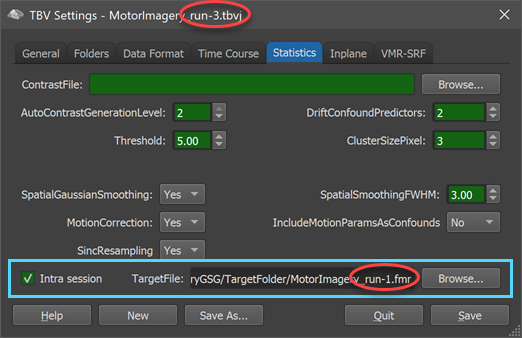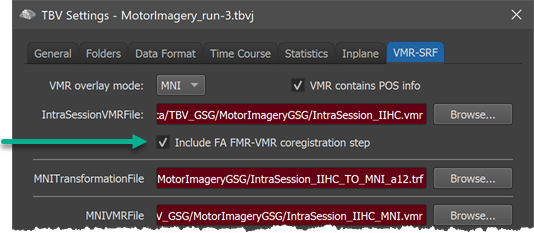Turbo-BrainVoyager v4.4
Multiple Runs within a Session
In most applications of real-time fMRI, multiple functional runs are analyzed within the same session. In neurofeedback applications, for example, it is important that ROIs defined after a localizer run refer to the same voxels in subsequent neurofeedback runs. There are several approaches possible in TBV to support this goal. In case that all functional runs are measured with the same spatial recording parameters (same number of slices, same slab position, same field of view and matrix size), ROI voxels defined in an earlier (e.g. localizer) run should be identical in later runs in case that the same ROI is re-used (e.g. preloaded) - except for displacements due to head movements between runs.

Intra-Session Motion Correction
In order to correct for head movements across runs of the same session, motion correction can be performed to a reference volume of a previous run. If, for example, a neurofeedback run wants to use an ROI from a localizer run, the localizer run can be specified as the motion correction target of the neurofeedback run resulting in tranformation of the volumes of the neurofeedback run into the same space as the volumes of the localizer run; if motion correction works successfully, this ensures validity of ROIs across runs. The screenshot above shows the TBV Settings dialog for the 3rd run (MotorImagery_run-3.tbvj) of the 'Getting Started Guide' dataset (the first run is a localizer run, runs 2 and 3 are neurofeedback runs); in order to align the volumes of the functional data of run 3 to the reference (i.e. first) volume of the localizer run, the Intra session motion correction option has been turned on and the FMR file MotorImagery_run-1.fmr has been selected as the target run. Note that at the end of analysis of a run, the full time course data is stored to disk as an FMR fille referencing a STC file with the same name that contains the full volume time course data. At begin of real-time analysis of the current run, the program will read the first volume from the specified functional data of the target run and use this volume as the target for motion correction.

Using across-run (intra-session) motion correction leads to large motion parameter values already at the begin of a subsequent run as indicated in the figure above. While looking surprising at first, this is to be expected when motion across runs is successfully corrected since the current run's first volume is no longer the reference for intra-run volumes but it is itself aligned to the first volume of a previous run. The parameter values at the begin of motion correction at a subsequent run, thus, reflect accumulated motion from the measurement time of the first volume of the first run up to the time when the current run's volume(s) are measured.
Alignment with 3D Anatomical Data
Since TBV 4.0, functional data can be aligned to intra-session anatomical data with high precision by using a gradient-based iterative fine-tuning or FA alignment step after standard initial alignment (IA) of coordinate systems as specified in file headers (or exernal POS files). After calculating the FA transformation matrix at the begin of a run, it will be saved to disk for later use (see below) with a file name scheme [func-run-name]-TO-[anat-name]_FA.trf that is composed of the functional run name and the coregistration target VMR name (e.g. MotorImagery_run-1-TO-IntraSession_IIHC_FA.trf for the first run of the Getting Started Guide dataset).

In the screenshot above the fine-tuning alignment option has been turned on by checking the Include FA FMR-VMR coregistration step option in the VMR-SRF tab of the TBV Settings dialog. While the initial alignment step is the same for all runs, the fine-tuning alignment step aligns each functional run individually to the intra-session anatomy thereby correcting for displacements of the functional data measured at different time points. This is a beneficial step when correcting head motion separately for each run. When, however, across-run motion correction is used as described above, this would introduce a second head motion correction step resulting in displaced visualization of functional maps and ROIs on 3D anatomical datasets. Turning off the option would avoid over-correcting FA alignment for subsequent runsi but FMR-VMR corgegistration would not benefit from enhanced coregistration. To solve this issue, TBV automatically uses the FA transformation matrix calculated and saved for the run referenced for intra-session motion correction instead of running FA alignment for the current run. Since intra-session motion correction aligns the current run to the space of the referenced run, the subsequent run will now be coregistered to the 3D anatomical intra-session data in the same way as the referenced run. In summary, the FA option can thus be turned on for all runs and the software will use the correct FA transformation during processing, i.e. it will use the FA tranformation from the referenced run in case of intra-sesson motion correction, and it will perform FA alignment for the current run if across-run motion correction is not used.
Copyright © 2002 - 2024 Rainer Goebel. All rights reserved.